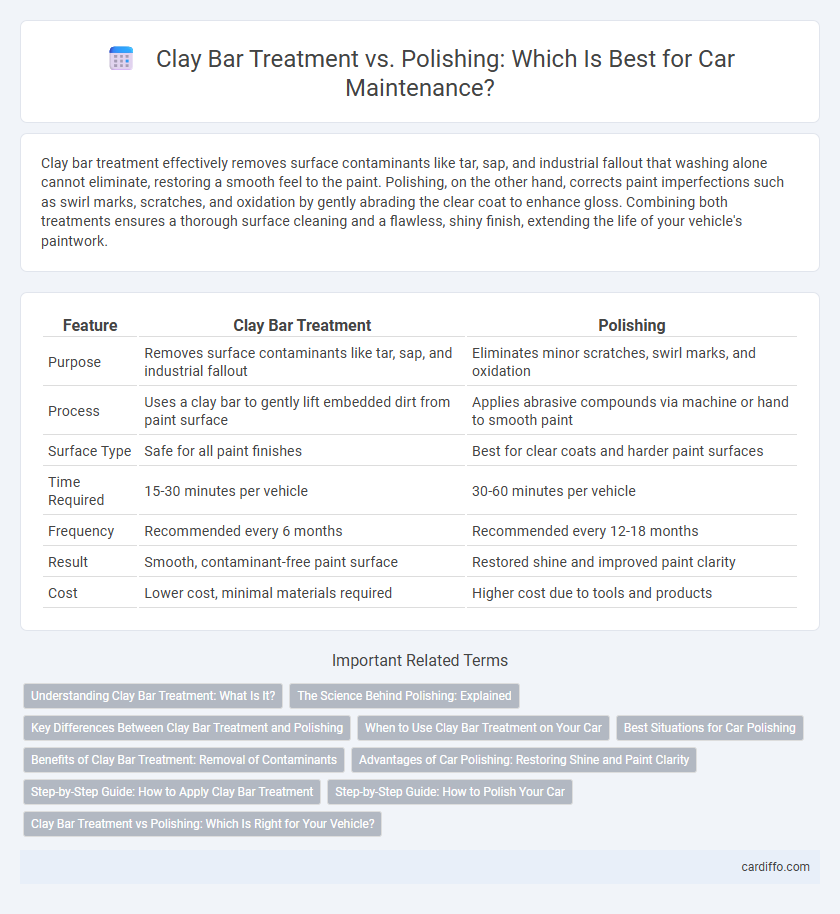Clay bar treatment effectively removes surface contaminants like tar, sap, and industrial fallout that washing alone cannot eliminate, restoring a smooth feel to the paint. Polishing, on the other hand, corrects paint imperfections such as swirl marks, scratches, and oxidation by gently abrading the clear coat to enhance gloss. Combining both treatments ensures a thorough surface cleaning and a flawless, shiny finish, extending the life of your vehicle's paintwork.
Table of Comparison
| Feature | Clay Bar Treatment | Polishing |
|---|---|---|
| Purpose | Removes surface contaminants like tar, sap, and industrial fallout | Eliminates minor scratches, swirl marks, and oxidation |
| Process | Uses a clay bar to gently lift embedded dirt from paint surface | Applies abrasive compounds via machine or hand to smooth paint |
| Surface Type | Safe for all paint finishes | Best for clear coats and harder paint surfaces |
| Time Required | 15-30 minutes per vehicle | 30-60 minutes per vehicle |
| Frequency | Recommended every 6 months | Recommended every 12-18 months |
| Result | Smooth, contaminant-free paint surface | Restored shine and improved paint clarity |
| Cost | Lower cost, minimal materials required | Higher cost due to tools and products |
Understanding Clay Bar Treatment: What Is It?
Clay Bar Treatment is a detailing process designed to remove embedded contaminants such as industrial fallout, brake dust, and tar from a vehicle's paint surface that regular washing cannot eliminate. This treatment restores paint smoothness by gently lifting pollutants without compromising clear coat integrity, making it an essential step before polishing or waxing. Unlike polishing, which removes a thin layer of paint to correct imperfections, clay bar treatment cleans the surface at a microscopic level, enhancing paint clarity and durability.
The Science Behind Polishing: Explained
Polishing mechanically abrades the vehicle's clear coat to remove surface imperfections by using fine abrasives that smooth out scratches and oxidation at a microscopic level. This process restores paint clarity and gloss through controlled friction and heat generated during polishing, which evens out the surface texture. In contrast, clay bar treatment physically lifts embedded contaminants without altering the clear coat's surface structure, making polishing a more effective method for correcting paint defects.
Key Differences Between Clay Bar Treatment and Polishing
Clay bar treatment effectively removes surface contaminants such as tar, tree sap, and industrial fallout, creating a smooth base without altering the paint layer. Polishing involves abrasive compounds to eliminate fine scratches and oxidation, restoring gloss and correcting minor imperfections. While clay bar treatment focuses on decontamination, polishing targets surface refinement and paint correction.
When to Use Clay Bar Treatment on Your Car
Clay bar treatment is essential when your car's paint surface feels rough or has embedded contaminants like tar, sap, or industrial fallout that washing alone cannot remove. This method effectively lifts impurities that cause dullness and hinder paint protection, making it ideal before applying polish or wax. Use clay bar treatment as a preparatory step to ensure a smooth, clean surface for optimal shine and long-lasting results.
Best Situations for Car Polishing
Car polishing is ideal for removing minor scratches, swirl marks, and oxidation to restore a vehicle's paintwork shine and smoothness. It is best suited for cars with faded or dull paint where surface imperfections need correction rather than just surface contaminants removal. Unlike clay bar treatment, which excels at deep cleaning and removing embedded contaminants, polishing provides a more refined finish by enhancing paint clarity and gloss.
Benefits of Clay Bar Treatment: Removal of Contaminants
Clay bar treatment effectively removes embedded contaminants such as industrial fallout, brake dust, and tree sap that washing alone cannot eliminate. This process restores a smooth surface by extracting microscopic impurities, enhancing paint clarity and preparing the vehicle for waxing or sealing. Regular clay bar treatment prevents paint deterioration and extends the lifespan of automotive finishes by maintaining a contaminant-free surface.
Advantages of Car Polishing: Restoring Shine and Paint Clarity
Car polishing effectively restores a vehicle's shine by removing minor surface imperfections and oxidation, enhancing paint clarity and depth. It smooths the paint surface, allowing light to reflect evenly, which revitalizes the car's original gloss and color vibrancy. Unlike clay bar treatment, which removes contaminants, polishing improves the aesthetic finish by refining the paint's texture for a polished, showroom-quality appearance.
Step-by-Step Guide: How to Apply Clay Bar Treatment
Begin the clay bar treatment by thoroughly washing and drying the vehicle to remove surface dirt and grime. Gently glide the lubricated clay bar over small sections of the paint, applying minimal pressure to lift embedded contaminants without damaging the clear coat. After each pass, wipe the area with a microfiber towel to remove loosened particles, then fold the clay to expose a clean surface before continuing.
Step-by-Step Guide: How to Polish Your Car
Start by thoroughly washing and drying your car to remove surface dirt before using a clay bar treatment, which eliminates embedded contaminants for a smooth finish. Next, use a dual-action polisher with a suitable polishing compound to restore paint clarity and remove minor scratches, working in small sections with consistent pressure. Finish by wiping off residue with a microfiber cloth and applying a protective wax or sealant to enhance shine and protect the surface.
Clay Bar Treatment vs Polishing: Which Is Right for Your Vehicle?
Clay bar treatment effectively removes embedded contaminants like tar, sap, and industrial fallout, restoring surface smoothness and enhancing paint clarity. Polishing, on the other hand, corrects paint imperfections such as swirl marks, scratches, and oxidation by lightly abrading the clear coat to reveal a fresh layer. Choosing between clay bar treatment and polishing depends on your vehicle's condition: clay bar treatment is ideal for maintaining contamination-free surfaces, while polishing addresses surface defects for a renewed finish.
Clay Bar Treatment vs Polishing Infographic

 cardiffo.com
cardiffo.com